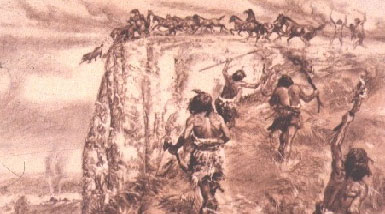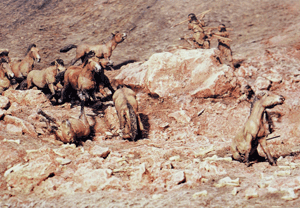A horse jump site?
The massive accumulation of horse bones under the escarpment, unique in the archaeological record, baffled specialists and intrigued the general public. Inspired by reports of bison kills in North America, Adrien Arcelin proposed in a novel, an interpretation which attracted a great deal of attention. In the novel, Paleolithic hunters chased horse herds up to the top of the escarpment and forced them to jump to their death.
More recent investigations showed, however, that the masses of horse bones were not under the cliff as could be expected but were in fact on the side and too far to fit the model. More convincing yet, the bones show little if any sign of the multiple fractures which would be there if horses had indeed jumped or fallen from the high cliff.
Recent excavations and modern studies of animal bones were conducted to arrive at a better, more satisfactory interpretation of the horse "magma". Currently accepted view proposes that hunters intercepted animal herds as they moved through the Solutré valley during their seasonal transhumance from the Alluvial Plain of the Saône to the Macônnais Uplands. They forced their prey into natural rock traps along the southern flank of the Roche just under the falt line where they could be slaughtered.
The ambush model best fits the evidence derived from the study of the piles of bones recovered during the excavations. Furthermore, the strategy is adapted to the capture of a wide range of game. Whereas horse was the exclusive prey of the Gravettian and the preferred one of Magdalenian, Aurignacian and Mousterian hunting parties, reindeer was hunted as well; and it was the dominant game of Solutrean hunts in a time period when the colder climate did not support horses.

